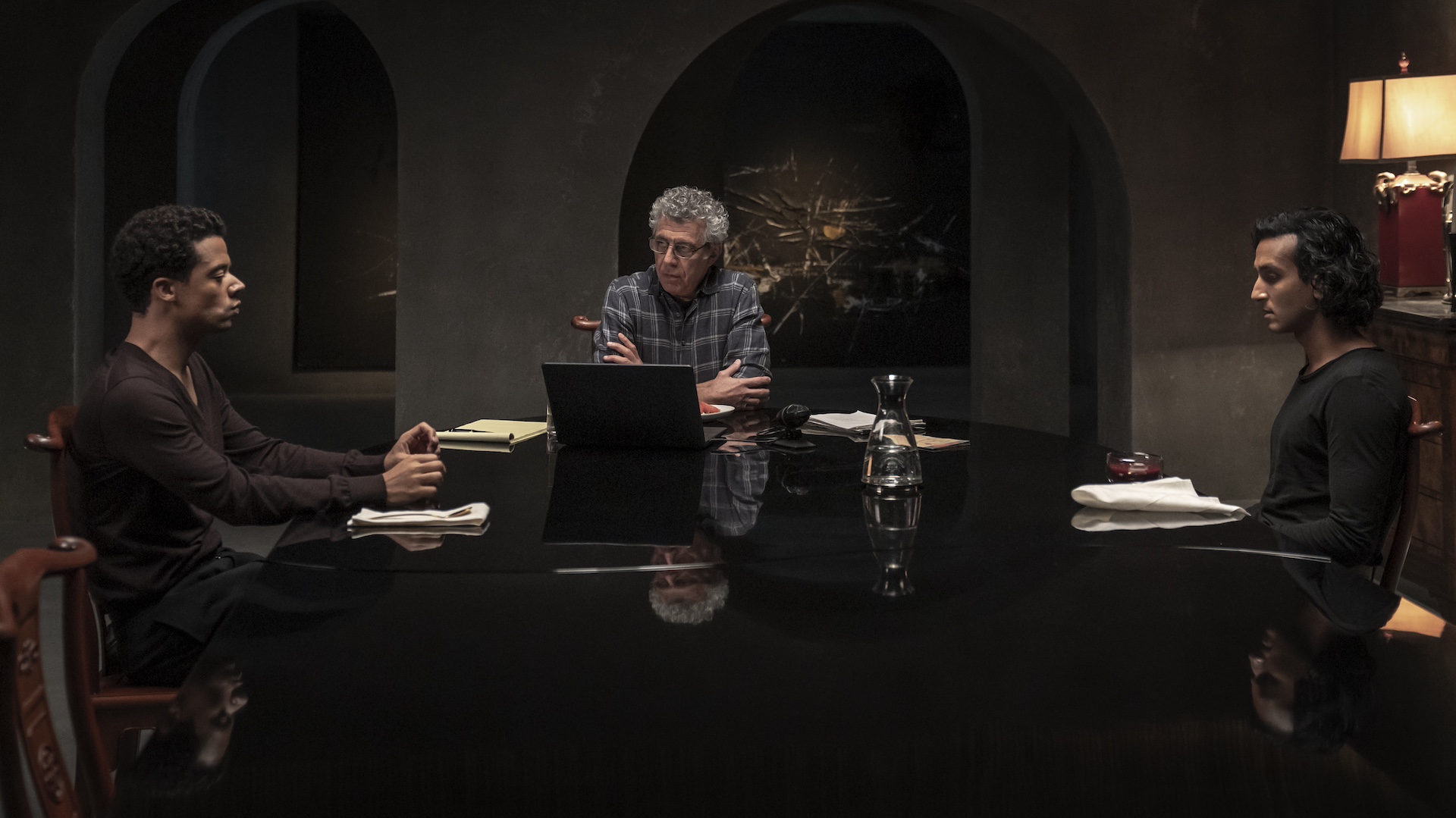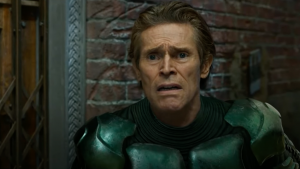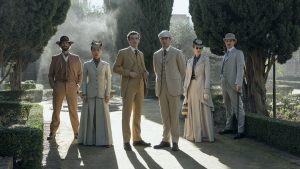
This article contains spoilers for Interview with the Vampire season 2 episode 8 and Anne Rice’s VAMPIRE CHRONICLES novels.
Loose ends are tied off like veins, and chestnuts drop like blood into wine flutes in the Interview with the Vampire season 2 finale. The title of episode 8, “And That’s The End Of It. There’s Nothing Else,” promises extreme closure but opens the doors to far more damage to come. Louis de Pointe du Lac (Jacob Anderson), exiled for the crimes against vampires which brought death sentences to Claudia (Delainey Hayles) and Madeleine (Roxane Duran), dispatches the repertory players of Théâtre des Vampires with incendiary critiques and dramatic exits. His rage conspires with his madness to destroy the Coven.
In the penultimate episode, “I Could Not Prevent It,” Claudia is executed for killing her maker, Lestat de Lioncourt (Sam Reid), and journaling about vampire secrets. In the season 2 finale, Louis goes a step further, allowing veteran journalist Daniel Molloy (Eric Bogosian) to publish a book chronicling undead history. It ends on a bloodbath with negligible nutritional value. What does all the carnage reveal?
How Do You Even Kill a Vampire?
Season 2 closes on the global vampire community’s reactions to the publication of Molloy’s exposé, which are brutal: “Page after page of heresy;” “He killed his own kind in Paris;” “He broke the Great Laws!” The punishments Louis psychically discerns from other vampires are graphic, and creative: “Lop off his head;” “Pull out his guts;” “Rip out his fangs and cut his tongue;” “Peel off the skin from cranium to coccyx;” “Stuff him in the oven like a chicken;” “Death by a thousand bites;” “Bite by bite to his marrow.” All very good suggestions, which Louis takes in stride. He owns the night.
Vampires are immortal beings. Powered by the blood of the living, they can influence minds, transform at will, and overpower an entire village of attackers by sheer strength and speed. What does it take to kill an eternal being already dead? The better question is: what wouldn’t? According to ancient folklore gathered from across the world, it is easier to kill vampires than get rid of bedbugs. Occult historian Montague Summers’ 1928 DIY bloodsucker-removal manual The Vampire: His Kith and Kin counts beheadings (some with garlic stuffing), stakings, burnings, upside-down burials, running water, Holy water, crucifixes and various holy relics, exposure to the sun, and a small bag of salt.
Anne Rice’s vampires are more resilient. They are not concerned with condiments, and only avoid religious iconography out of an ancient ironic respect. But they are night creatures, confined to darkness and artificial light. In “I Could Not Prevent It,” Santiago (Ben Daniels) leads the troupe in a rare matinee performance as they execute Claudia and Madeleine by positioning them directly under the rays of the sun.
Louis’ offensive retribution is the most efficient way to exterminate a house full of bloodsucking immortals. Most of his work is done by the notorious fire which destroys the theater. He stands under the stairs to slash the feet of any vampires trying to escape, and uses a machete on the survivors.
So, Daniel is a Vampire Now?
As Daniel warns Louis to get out of Dubai, it comes out the journalist changed his diet. He is now a vampire, and his maker is Armand (Assad Zaman). Louis, who just balked at Interview with the Vampire merchandising, frames the transformation as a “burden out of spite.” This is a perceptive conclusion. In the books, Daniel repeatedly asks Armand to be darkly gifted. The requests invariably revert to “the same old dance,” but Armand leads.
After undergoing the conditioning seen in episode 5, “Don’t Be Afraid, Just Start the Tape,” but expanded on in the books The Vampire Lestat and The Queen of the Damned, Daniel is relentlessly summoned to the older vampire. He can’t eat or sleep, and all he can think of is Armand. “You’ll torment me forever, and then you’ll watch me die,” the journalist asks the ancient vampire. But Armand does not wish to burden Daniel with immortality, saying, “I’d rather die than do that.” In face of the anger of encroaching, offended vampires wanting payback for the book’s revelations, Daniel is “one of a billion faceless humans.” As a vampire he would be “a candle burning in the dark. They would spot you without fail.” And while Daniel hears “the cry of danger” in the book, Armand ultimately does bestow the Dark Trick on a no-longer-young-and-sprite Daniel.
Who is Akasha?
The name Akasha is a detail Daniel has not yet uncovered in discovery. Akasha is the reason Lestat enjoys the power he holds as an immortal vampire. Her name is not mentioned in Rice’s novel Interview with the Vampire. Louis does not know of her existence.
The titular character of The Queen of the Damned, Akasha is the most powerful vampire in existence. She was darkly gifted in Uruk (now called Iraq), in the Tigris and Euphrates Valley, around 4011 B.C. Also called the Queen of Comets, and the Great Mother, Akasha became the Queen of Kemet when she paid it forward, bestowing the Dark Trick on the most powerful figure of the time. “And deep into biblical times we are led to confront our first parents: Enkil and Akasha, rulers of the valley of the Nile before it was ever called Egypt,” Rice writes. “Kindly disregard the gobbledygook of how they became the first bloodsuckers on the face of the earth.”
All vampires “are descended from this venerable pair … the primal generator of all our delicious and indispensable powers resides in one or the other of their ancient bodies.” This is far more serious than it may sound. For all vampires, this means “if Akasha and Enkil should ever walk hand in hand into a furnace, we should all burn with them. Crush them to glittering dust, and we are annihilated.”
Akasha and Enkil are known to select vampires as “Those Who Must be Kept.” The ancient Roman vampire Marius tends to them in a secret crypt. Lestat disturbs their slumber with a rousing violin performance. Legends infer Akasha shared her primal blood with Lestat.
Rice’s follow-up to Interview with the Vampire, The Vampire Lestat, should have been subtitled: “Lestat’s early education and adventures.” The true source of his powers, and responsibilities, are revealed in The Queen of the Damned. Akasha was so powerful the cinematic universe skipped entirely over the novel The Vampire Lestat to cast Aaliyah as the first vampire in Michael Rymer’s Queen of the Damned.
What Will Interview with the Vampire Adapt Next?
AMC’s adaptation of The Vampire Chronicles will not make the same mistake. AMC renewed Interview with the Vampire season 3, and know The Vampire Lestat is indispensable, noting “the Vampire Lestat sets his story straight in a way only he can,” according to Deadline. Because Akasha is mentioned in the season 2 finale, it is a good bet we will see elements of The Queen of the Damned represented in season 3. Much of the events will pull from future books, especially as the series moves forward in Dubai. At the 92nd Street Y premiere screening in Manhattan, series creator and executive producer Rolin Jones expressed excitement about a season covering The Vampire Armand (1998).
Anne Rice’s The Talamasca will add one more series to AMC’s Anne Rice Immortal Universe beginning in 2025. It will feature the secretive society recently mentioned by Raglan James, and is a large part of Anne Rice’s Mayfair Witches.
The post Interview with the Vampire Season 2 Ending Explained: How Can a Vampire Be Killed? appeared first on Den of Geek.






